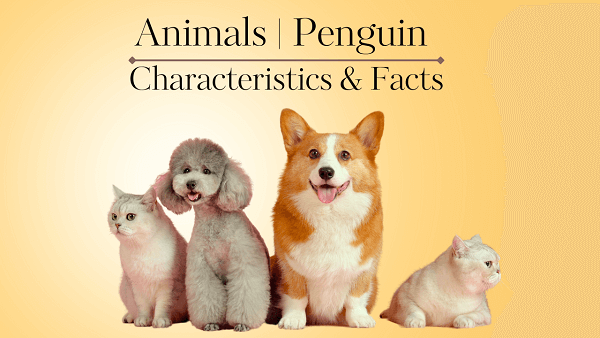
Penguin Definition | Characteristics & Facts
Penguin Definition
Penguins are flightless birds that inhabit the Southern Hemisphere, primarily in Antarctica. They are characterized by their upright stance, wings modified as flippers for swimming, and black and white plumage
Penguin General Characteristics & Facts
- Penguins are flightless birds that are highly adapted for life in the water. They are found primarily in the Southern Hemisphere, especially in Antarctica, but they can also be found in coastal areas of South America, Africa, and New Zealand.
- Penguins have streamlined bodies, flipper-like wings, and webbed feet, which make them excellent swimmers. They are known for their unique way of swimming, using their wings as flippers and their feet for steering.
- Penguins are social animals and often form large colonies for breeding and raising their chicks. They have a complex courtship behavior and are known for their elaborate displays of affection and dedication to their mates.
- These birds have a thick layer of blubber and dense feathers that provide insulation, helping them withstand extremely cold temperatures in their native habitats.
- Penguins feed primarily on fish, krill, and other small marine creatures. They are skilled hunters, using their streamlined bodies and excellent underwater vision to catch their prey.
- Heights of penguins up to 4 feet (1.2 meters). Pengiun weighs up to 90 pounds (40 kilograms). The smallest penguin species is the little blue penguin, which stands about 13 inches (33 centimeters) tall and weighs around 2 pounds (1 kilogram).
- Penguins are highly adapted to life in water, but they also come ashore to breed and molt. They build nests or use burrows to protect their eggs and chicks from the harsh Antarctic conditions.
- Despite their cute and waddling appearance, penguins are skilled and agile swimmers, capable of diving to great depths. Some penguin species can dive as deep as 1,800 feet (550 meters) and hold their breath for several minutes.
- Penguins have a unique method of thermoregulation called "countercurrent heat exchange." Blood vessels in their flippers and legs are closely situated, allowing warm arterial blood to transfer heat to cool venous blood, helping them conserve body heat in cold water.
- Penguins are popular and beloved animals, often depicted in movies, cartoons, and various forms of media. They have become iconic symbols of the Antarctic and its unique wildlife.
Read our Animals Encyclopedia with Complete Facts
Physical Characteristics Penguin
- Body Shape: Penguins have a streamlined body shape, which is well-suited for swimming through water. Their bodies are tapered at the ends, with a broad, flattened chest and a narrow waist. This shape minimizes drag and allows them to move efficiently in the water.
- Feathers: Penguins are covered in dense and waterproof feathers. Their feathers are tightly packed and overlap, forming a smooth surface that helps reduce friction while swimming. The feathers also provide insulation, keeping the penguins warm in cold waters.
- Coloration: Most penguins have distinct coloration patterns. Their backs are usually black or dark gray, which helps camouflage them when seen from above against the dark depths of the ocean. Their bellies are white or light-colored, which provides camouflage against the bright sky when seen from below. This coloration helps them blend in with their surroundings and provides protection against predators.
- Wings and Flippers: Penguins have modified wings called flippers. These flippers are short, stiff, and paddle-shaped, allowing them to act as powerful oars for propelling through the water. Penguins use their flippers to steer and change direction while swimming. Although they are not capable of sustained flight in the air, penguins use their flippers for balance and stability on land.
- Feet and Webbed Toes: Penguins have webbed feet with thick, strong claws. Their feet are adapted for swimming, providing propulsion and steering in the water. The webbed toes help penguins move efficiently through the water by increasing surface area and reducing drag.
- Beak: Penguins have a sharp, pointed beak. The shape and size of the beak vary among different species. The beak is used for catching and grasping prey while hunting in the water. It is also used for communication and preening their feathers.
- Size and Weight: The size and weight of penguins vary depending on the species. The largest penguin species, the emperor penguin, can reach a height of about 3.7 feet (1.1 meters) and weigh up to 88 pounds (40 kilograms). Smaller species, such as the little blue penguin, are around 13 inches (33 centimeters) tall and weigh about 2.2 pounds (1 kilogram).
Continue To Explore All Animals That Start With P
Scientific Classification of Penguin
Kingdom: Animalia
Phylum: Chordata
Class: Aves
Order: Sphenisciformes
Family: Sphenisc
Key Locations of Penguin
- Antarctica
- Subantarctic Islands
- Southern South America
- South Africa
- New Zealand and Australia
View All A-Z Animals List
What does Penguin eat the Most?
- Fish
- Krill
- Squid
- CrustaceansOther Marine Organisms
How do Penguins express their love?
Shout your love to the heavens.
What questions do I need to know about penguins?
When learning about penguins, there are various questions you can explore to gain a comprehensive understanding of these fascinating birds. Here are some key questions to consider.




